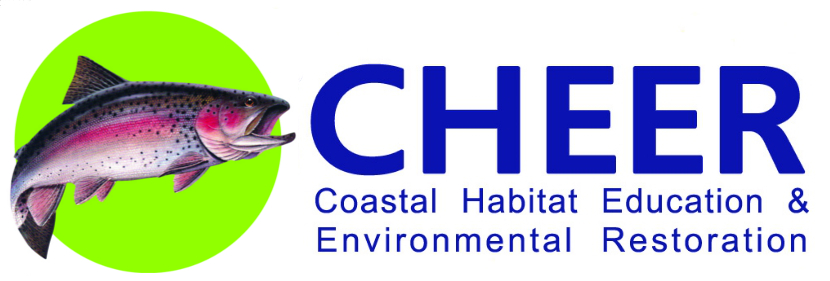“CHEER is excited to announce our 4th Annual Dinner and Awards Fundraiser! This dinner helps sustain and expand CHEER’s education and restoration programs! Can’t wait to see you all there!”
Looking to donate!
By clicking the donate button you will have a chance to make an impact on our local environments sustainability. Any amount helps and we greatly appreciate all that we have received and our future donators!
Uvas Creek Steelhead Rescue!
Ever since I worked on my steelhead movie for NOAA, NMFS in Long Beach, I have been fascinated with the California creek ecosystem and steelhead trout. Steelhead, (Oncorhynchus mykiss) could tell a very interesting story about their life, if only they could talk.
Adults deposit eggs and milt in gravel within creeks and rivers that have fast moving water. Fish swim up the river during the Winter and Spring and the eggs hatch in the Spring and Summer. Some fish remain in these creeks their entire lives and become rainbow trout while others migrate to the ocean and live at sea until they are ready to return to their natal stream to spawn. Unlike all other types of salmon that die after spawning, ocean-going steelhead can spawn more than once and over the course of many years they migrate up and down a river, much like people traveling along freeways.
Steelhead migrate up the river during and right after big winter storms, while the water levels are high. Throughout their travels they have to avoid manmade hazards and swim dozens of miles until they reach proper spawning grounds that have just the right size spawning gravel and shaded trees that will drop insects to feed their young. Some fish spawn right away and head directly back to sea while others stick around for a while. In times of sufficient rainfall, dams release water into creeks via their spillways but during times of low rainfall and drought, they release less and less water. As seasons change from spring to summer the creek water levels evaporate. Farmers need more water for their crops and drop by drop many of the creeks become too shallow to support fish and sometimes go bone-dry. During these times the adult fish that stuck around and the young of the year all run into trouble. Now that I live up here in the Central Coast, I have a great opportunity to observe steelhead up close. After moving, I found out about a non-profit organization called CHEER, which stands for Coastal Habitat Education and Environmental Restoration. CHEER’s president Herman Garcia, his board and dozens of volunteers work along creeks in Gilroy and the Pajaro Watershed to rescue steelhead. The fish swim from the Monterey Bay National Marine Sanctuary, up the Pajoro River through heavy agriculture land and then up Uvas Creek to connect with spawning grounds. Before the dam was built in the 1950’s, the steelhead swam in the upper Uvas watershed to spawn. Now the fish settle for Uvas Creek and her tributaries below the dam. At least this area has spots the fish find suitable for spawning.
Most of the CHEER volunteers are fishermen who have come to the realization that if they do not do volunteer during seasonal creek dry backs, they may not be able to catch and release a steelhead in their hometown.
Steelhead problems do not only happen in Gilroy, they are statewide. Herman advises councils like the Mid-peninsula Regional Open Space District, the County of Santa Clara, County of Santa Cruz, towns of San Jose and Palo Alto on what to do when they have a fish dilemma.
It could be something as simple as rescuing fish during dry backs or more complex like pinpointing sources of water pollution, or trying to find solutions to the homeless encampments that are attracted to life along the watershed. CHEER does what NOAA and the California Department of Fish and Wildlife (CDFW) have trouble doing, connecting directly with landowners on a regular basis. With the CHEER team working closely with CDFW, thousands of fish have been saved since 1996. CHEER has a slogan that says “No Fish Left Behind” and they stand by their motto. Rescued fish are moved to an area of the watershed that is less likely to dry up. When the winter rains return and the creeks and rivers once again fill with water, reconnecting to the sea, the cycle of life continues…
Long Live the Steelhead!
Content provided by
Milbrand Cinema
Phone: (408) 353-1287
Milbrand Cinema is located in wine country, half-way between Santa Cruz and San Jose, California. Exit off Hwy-17 and Summit Road in the Santa Cruz Mountains. From this location its one-hour to Monterey, 1:30 to San Francisco.
Video Courtesy of Milbrand Cinema
For more about Milbrand Cinema and an excellent portrayal of what CHEER does on a day to day basis. Check out the documentary they produced about us.
CHEER Beginnings
Founded on donations in 2003, CHEER was incorporated as a non-profit organization. In the first several months, the organization began building infrastructure. An experienced and talented entrepreneurial team dedicated to community improvement was put together. The team has negotiated conservation easements essential to pilot-project start-up and has identified and contacted program supporters. CHEER is now being supported by various funding opportunities for designated current and future projects.
Our Mission & Philosophy
Coastal Habitat Education Environmental Restoration, also known as CHEER, is an organization with a fresh take on environmental programming. Its mission is to restore coastal ecosystems but do so in a way that safeguards resource-based local economies. CHEER recognizes that varied interests are represented in local economies. It believes that assessing and reconciling these interests so that each group profits by cooperation in restoration efforts is the key to more effective environmental programming.






